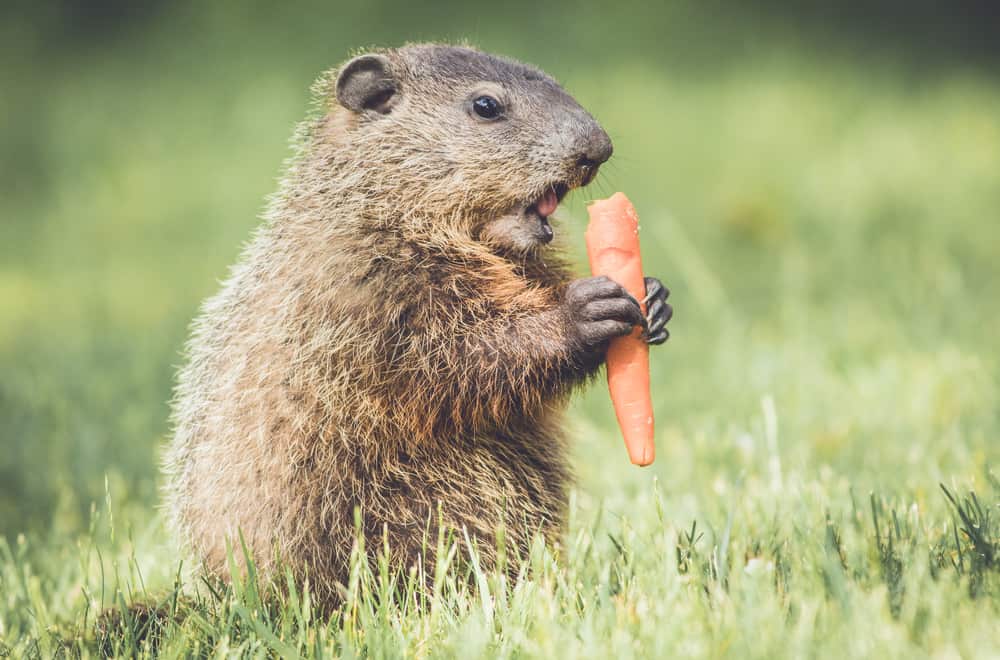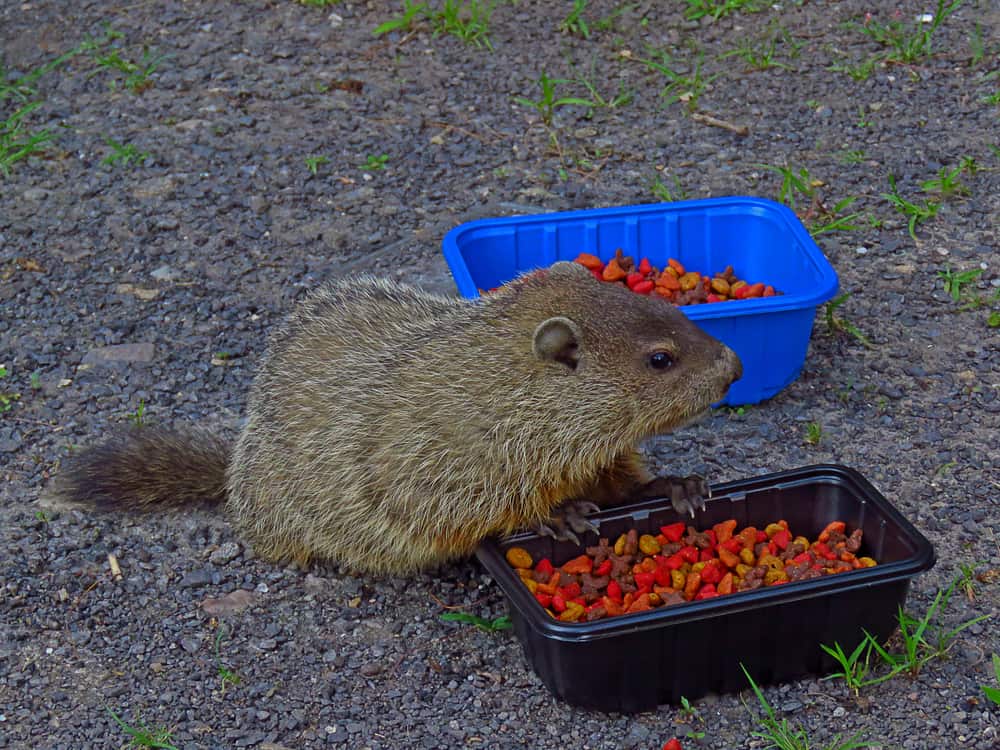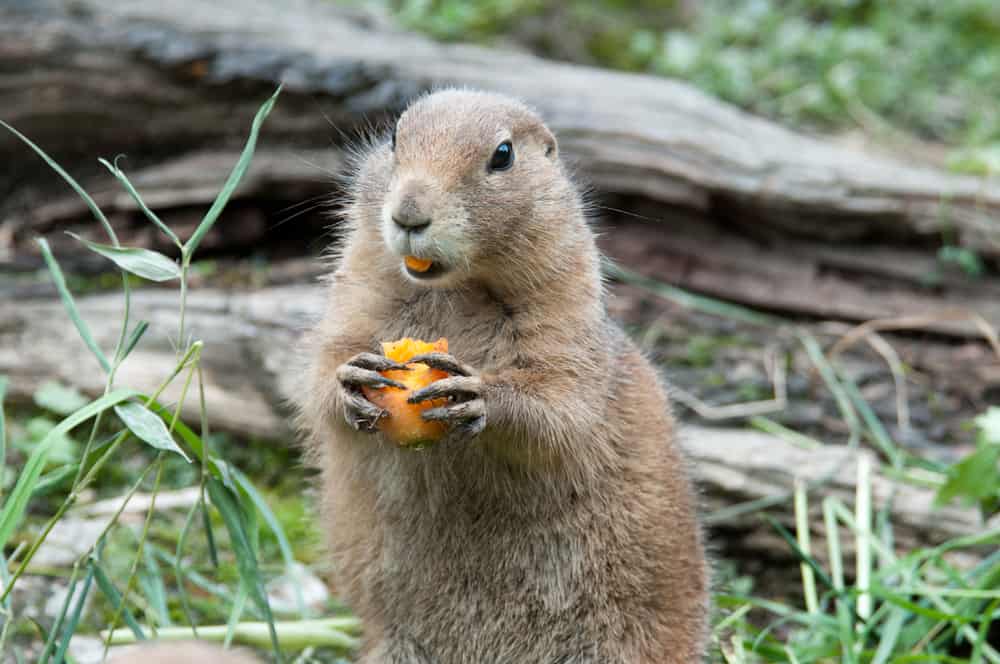Did you know that groundhogs are practically a farmer’s nightmare? This “small bear’s” appetite and chewing power are astonishing. But can you blame them? They need to keep eating and eating some more to ready themselves for winter.
Groundhogs are powerful diggers besides their love for food. So, what do groundhogs eat?
Groundhogs Habits And Biology
Groundhogs, also known as woodchucks or ground pigs, belong to a family of large ground squirrels and weigh upto 6kgs. They are primarily found in North America and Canada.
Wild groundhogs live up to six years and are the largest of the squirrel family.
Groundhogs are solitary except for early spring after they emerge from hibernation to seek out females to mate.
Farmers hate groundhogs as they eat their crops. Groundhogs can overtake your property. They eat flowers and plants in gardens and also eat grasses and weeds found in your yard. Seedlings are also not spared by woodchucks and are eaten before they grow.
Surprisingly, groundhogs don’t drink water. They stay hydrated from eating succulent (juicy) plants wet from dew or rain. Did you know that groundhogs can also swim? Swimming helps them escape predators, and their burrows also keep them safe.
Did you know that female groundhog give birth to blind and hairless babies? They give birth after one month, and their babies are called pups or kits.
Groundhogs front teeth (incisors) are ever-growing and only wear down through continuous usage. Let’s not forget about their sharp claws. The constant digging from groundhogs keeps their nails at a decent length.
In late summer, continuing into fall, groundhogs feed a lot taking in nutrients to build up fat reserves for winter. They hibernate in burrows (underground tunnels) which are upto 6ft deep during the cold months of winter, as they encounter difficulties finding plants to eat.
Groundhogs remain in hibernation from October till February, where their breathing and heart rate drop. Bear in mind; they hibernate less in areas with hotter temperatures than those with lower temperatures, meaning they can emerge from hibernation sooner or later, depending on their location.
Groundhogs are primarily herbivores as their diet consists mainly of plants.
What Do Groundhogs Like To Eat Most?
Woodchucks eat a wide variety of plants, greens, and vegetables. Did you know that they also eat flowers? Here’s a breakdown of what our cute friends love to eat.
- Plants- Alfalfa, clovers, dandelions, maple leaves, daisies, grass, flowers, chicken weed, sorrel (leafy green vegetable) are some plants groundhogs cherish. A garden full of plants is a paradise for groundhogs. Ferns are another plant they like to eat.
- In spring and summer, plants are plentiful for groundhogs to eat. As they emerge months later from their burrows after hibernation, they are always eager to get back to their eating hobby.
- Alfalfa is available in late summer and provides groundhogs with a dense meal to eat.
- Groundhogs live in open fields, fence rows, or tree bases to ensure they get unlimited access to plants, greens, and fruits.
- Cultivated crops- They love to eat soybeans, plantain, broccoli, celery, squash, corn, peas, carrots, cabbage, and lettuce.
- If you want a groundhog as your furry neighbor, grow the previously mentioned crops. How do you expect them to resist fresh lettuce from your garden?
- Fruits- Up up and away! Groundhogs can go as far as climb trees to eat fruits like red berries, blackberries, apples, cherries, mulberries, hackberries, and pears.
- Flowering plants- Marigold, snapdragons, sunflowers, and asters (flowers ranging from white to blue to purple) are not spared by groundhogs. No, male groundhogs won’t use these flowers to propose to their female counterparts; instead, they will chow them down.
- Nuts- Shagbark, hickory, acorns (nut of oaks and contains seeds).
- In fall, groundhogs also eat roots, leaves, barks, and twigs of trees as plants become scarce though they prefer plants and vegetables.
Woodchucks occasionally eat meat in the form of birds’ eggs, grubs, grasshoppers, crickets, june bugs, and larvae (immature form of insect) that they come across. Insects provide groundhogs with a good source of protein.
Are you a morning person? Well, groundhogs are. They forage for food in the morning up until early evening. To keep up their body weight, they barely move in hibernation.
Foods To Avoid When Feeding Groundhogs
There are certain scents and flavors in foods that groundhogs hate—these range from herbs and spices to flowers with powerful fragrances. Some items on the below list will surprise you.
- Groundhogs dislike the smell of herbs such as thyme, rosemary, oregano, mint, basil, sage, and chives, according to the Farmers’ Almanac. However, these herbs and spices are very healthy for humans.
- As much as groundhogs love to feast on flowers, there are certain flowers you wouldn’t find them munching on. Lily of the valley, lavender, hellebores, and yarrow are a few of these.
- These flowers have strong smells and are toxic to groundhogs. Hellebores have tough leaves, making them unpalatable for groundhogs.
- Lily–of–the–valley is toxic to animals, including groundhogs.
- If you have planted lavender in your garden, this flower will indeed thrive. Lavender has such a strong scent that it repels groundhogs. We, humans, love the smell.
- Sweet alyssum is a white aromatic flower that groundhogs also dislike.
- Garlic- Groundhogs loathe the pungent smell of garlic, according to Farmers’ Almanac. If you grow garlic in your garden, rest assured these pesky rodents will keep their distance and not eat them.
- Black pepper and cayenne pepper- Again, groundhogs generally dislike these spices due to their smell. These spices can also be used to drive them away from your garden when applied to their burrows.
Groundhogs tend to stay away from the above, but eating these foods becomes a likely possibility if they are starving.
Tips For Feeding Groundhogs
Groundhogs are creatures that can fend for themselves and look for food in warmer months. However, you may come across an orphaned baby groundhog that needs your help. Where would you even begin? Here are tips to take care of a pet baby groundhog.
- First and foremost, you must keep the baby groundhog warm.
- It would be better to wear gardening gloves as you need to avoid picking them up with bare hands.
- Offer them Pedialyte (a dehydrating solution) as they may suffer from dehydration. Ensure you have warmed the solution to body temperature.
- Esbilac powder- a puppy milk replacer is safe to give a baby groundhog.
- You can purchase esbilac from a pet store.
- Please refrain from giving baby woodchuck baby formula, and cow’s milk as these could cause death.
- It would be best to use an oral syringe instead of a bottle to feed the baby groundhog to prevent it from over-feeding.
- Cover its eyes and hold the groundhog in a towel after warming the formula.
- Ensure the baby groundhog doesn’t suck the formula too quickly by feeding it slowly. If it sucks the formula speedily and starts sneezing, turn upside down, and rub its back. Clean its nose afterward.
- Repeat this for about five minutes until its breathing goes back to normal.
- Clean the groundhog’s face once done with feeding by using a wet cloth because if the formula dries on its face, it will suffer a loss of fur.
- Baby woodchucks need to be stimulated to urinate before and after feeding.
- You can help a woodchuck to urinate using a Q-tip dipped in warm water. Lightly stroke above the genital area as this will cause the woodchuck to urinate. The woodchuck’s bladder can rupture if not stimulated.
- At about four weeks, start to introduce solids to the baby groundhog. You can start by feeding it a banana or an apple. As time passes, include vegetables and greens in its diet.
According to Pet Care Tips, follow the above steps to ensure a baby groundhog’s survival until the time comes when you can release it into the wild. If you feel overwhelmed and unable to care for a baby groundhog, you can contact the necessary pet care officials and ask for assistance.
FAQS (Frequently asked questions)
How can you get rid of groundhogs?
You can use human hair clippings as groundhogs don’t like the smell of humans. Groundhogs also dislike the smell of castor oil, which you can pour on the openings of the burrows when the groundhog is away.
Can groundhogs get into houses?
A groundhog can create a tunnel beneath your house, causing damage and loosening the ground upon which your home is built.
How can you distinguish between a male and a female groundhog?
Males are slightly larger than females in size.
Can groundhogs attack humans?
Groundhogs look like small bears while standing on their hind legs. As they are large, humans can fear them, but they rarely attack humans unless they feel threatened.
Summary
Groundhogs spend their lives eating and sleeping. They may be quite a nuisance due to their destructive eating habits, but you can’t deny their fantastic ability to hibernate for many months. These creatures love their freedom, and if you happen to come across one, don’t be scared.



I always attract the undesirables… First it was the skunks, that I learned from, next were the raccoons and feral cats, again I learned from, then the black vultures… again I learned from and now I feed a groundhog:) All are tame if you show respect. I was able to feed the feral cats and hand feed the wild raccoons. Females are thought to be rabid when they are seen during the day in June… my area in PA. They are just looking for water as they nurse there young. I was also able to hand feed the black vultures… they mate for life. I have seen up close what a vulture can do and as I tell you this, I only received a little blood blister from trying to touch it. Awesome birds that are so misunderstood and as I could feed them, the smallest of hamburger speck on my hand was gently taken. The skunks, they came in for a ground feeder but would come out of our deck steps between my legs or just under them. We love all our extended family and care for them.
Same here, we live in GA and have fed raccoons, feral cats (the same cat for 4 years) and the raccoons are more apt to let us near than the cats. We now have a groundhog family; so far we have seen mother and 2 babies
And are feeding carrots, celery and apples. Year round we have 5 bird feeders we keep full of black sunflower seed and wild bird feed of nuts and berries. Also dried meal worms. The squirrels and chipmunks get their share as well. We get all types of birds including crows, bluejays and mockingbirds which live the cats food as well. Our state bird; the Brown Thrasher love the meal worms. Robins; we call “the stuck up birds” because they feed near by but never come to our feeders 🤷🏼♀️ My neighbors have called me Cinderella because they say wildlife seems to be attracted to me 😆 Feeding all of this wildlife brings us such joy, even though there is an increase in the cost of food, we can’t imagine not feeding, especially in the Spring when the parents begin bringing their fledgling birds to feed. It’s adorable to see them hoping behind the father, flapping its wings and tweeting to be fed 💕.
*hopping not hoping 😁 we also feed Cardinals, Titmice, Nuthatches, Carolina Wrens, Chickadees, Eastern Doves, Brownheaded Cowbirds, Eastern Towhees, and we have raised two Eastern Starling fledglings that fell out of the nest; feeding ALL day for 8 days live meal worms then dried. Water with a syringe in the corner of their mouth. I taught them to bathe when all their feathers came in and treated them for mites. The slept on my kitchen table in a boot box at night and woke with the sunrise ready to eat. It was so sad when they would practice flying and I cried the day they didn’t come back. It was a wonderful experience.
YOU ARE A WONDERFUL PERSON DEBBIE. MAY GOD BLESS YOU FOR YOUR KINDNESS FOR THOSE WHO CANOT SPEAK FOR THEMSELVES. 🙏🌈👍💖
Thank you for all you do for our worlds creatures.
amen !!
‘Offer them Pedialyte (a dehydrating solution) as they may suffer from dehydration.’
Correction – Pedialyte is a REhydrating solution.
I have a groundhog and her baby, 3 squirrels, & 2 chipmunks in my backyard that I feed nuts and berries and veggies to. I love animals.
Good Girl ! i feed ALL of the critters in my area !
I AM A REAL ANIMAL LOVER !! ❤😊
Pest control services are very important in order to control the environment in residential and industrial buildings. Due to the constant interaction between people and their surroundings, human residences and offices are continuously “under attack” by various pests: ants, bed bugs, cockroaches, rodents, etc.
We have groundhogs. I appreciate that they keep their distance. I know the damage their digging can do but can’t help but have respect for them because of their healthy diet. I toss them corn on the cob in season. Sometimes celery, romaine, grapes. When we have too many, our neighbor traps them in humane traps and releases them in rural areas near water.
I have 2 woodchucks as pets. Their loving, smart, stubborn and quite adorable. I’ve had alot of different pets and they are my favorite. I would love seeing woodchucks in my yard. I’d make them their own garden are that they can raid and my plants would be in a different spot. We have deer that sleep in our yard